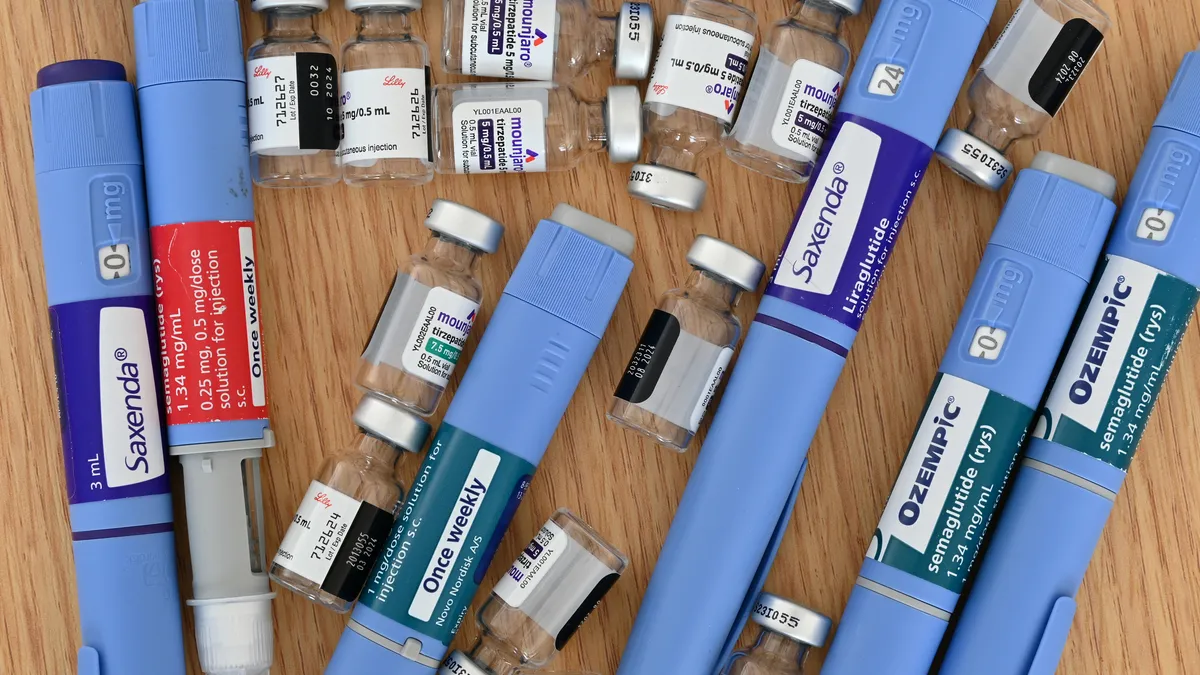What could GLP-1 drugs, known for their powerful weight loss benefits, have to do with oncology? Potentially “everything,” according to Deborah Phippard, chief scientific officer at the clinical research organization Precision for Medicine.
Popular drugs like Novo Nordisk’s Ozempic and Wegovy and Eli Lilly’s Mounjaro and Zepbound have such versatile effects that they could play a role treating not only diabetes and obesity, but cancer too, Phippard said.
“These are some of the most complicated drugs I’ve seen in my career because they do so many things,” Phippard said. The receptor these drugs bind to “is at the top of so many different pathways, and there are so many downstream effects that feed back in.”
The August U.S. approval of Wegovy for the liver disease metabolic dysfunction-associated steatohepatitis, or MASH, is a testament to the widespread impact a GLP-1 drug might have, as even the Food and Drug Administration acknowledged that the medicine was able to treat the condition through mechanisms that are not “fully understood.”
For the same reasons, GLP-1s could impact cancer patients as well, Phippard said. A large study in 1.6 million people with Type 2 diabetes found that those receiving GLP-1s had lower risk of developing many related cancers.
“If you’re obese and diabetic, you are at higher risk of any number of cancers, which is well-documented,” Phippard said. “Pancreatic, endometrial, ovarian and colorectal cancers in particular have been found to be driven by insulin resistance, so controlling obesity should theoretically take cancer incidents down.”
Beyond the benefits of weight loss to reduce cancer risk, the Swiss-army knife nature of GLP-1s could overlap with different pathways that govern how cancer forms and spreads from an immunological standpoint, she said.
“Looking at the function of specific T cells, NK cells, macrophages, dendritic cells, all of those functions you can demonstrably show change with a GLP-1 agonist,” Phippard said. “The MAP kinase pathway, the NF-kappa B pathway, VEGF — GLP-1 is upstream of all of these.”
The data around these pathways and the health risks associated with them is “messy,” Phippard acknowledged, but understanding clinical outcomes for patients being treated for cancer who are also on a GLP-1 could reveal actual effects.
GLP-1s and cancer therapy
Early research has shown that GLP-1s could potentially help overcome chemotherapy resistance, which would theoretically improve outcomes for cancer patients, though Phippard again noted the exact mechanism “isn’t brilliantly well understood.”
And with the drugs’ known effects on the immune system, they may also boost the effects of cancer immunotherapies like Merck & Co.’s Keytruda or Bristol Myers Squibb’s Opdivo, Phippard said.
“If you look at immune cells in an obese person, they don’t work that well and aren’t very healthy, but a GLP-1 can help,” Phippard said. “I’m always a little hesitant at that because the immune system is very complicated and massively redundant, but we should explore these areas further.”
Earlier research had raised some concerns of a link between GLP-1 drugs and thyroid or pancreatic cancer arose, according to the MD Anderson Cancer Center. But subsequent studies haven’t confirmed that connection.
Still, physicians so far are being careful with GLP-1s in oncology, particularly with pancreatic cancer patients or those already suffering from gastrointestinal problems that a weight loss drug could exacerbate. Muscle loss is also associated with long-term GLP-1 use, which could make patients more frail over time.
“Pancreatic, endometrial, ovarian and colorectal cancers in particular have been found to be driven by insulin resistance, so controlling obesity should theoretically take cancer incidents down.”

Deborah Phippard
Chief scientific officer, Precision for Medicine
Ongoing and future clinical studies for cancer could provide important clues. With nearly 12% of all Americans having taken a GLP-1, the odds of patient overlap with clinical trials are growing, Phippard said, and researchers need to better understand those implications to ensure accurate data.
“We’re right at the beginning of how we work this out, but I think you’ve got to run a clinical study looking at this with a separate statistic even in its own right,” Phippard said. “I don’t think we’ll ever be able to pull it entirely apart, but I’m not planning on retiring anytime soon.”
A standalone oncology treatment?
The idea of using GLP-1s to treat cancer, on their own, is a ways away, Phippard said.
“We are not remotely close to a GLP-1 alone for cancer treatment,” she said. “There may be one or two patients who start a GLP-1 for whatever reason, and their immune system picks up, but that’s an anecdotal n of 1.”
But the drugs may be useful as a combination treatment alongside chemotherapy or immunotherapy.
Currently, “combo therapies are happening by accident” with patients both on a GLP-1 and undergoing cancer treatment at the same time, Phippard said. And companies like Lilly, which sells drugs for cardiometabolic diseases as well as cancer, could start thinking about pairing them up in oncology trials without having to buy new assets.
“I’m expecting to see this coming out at all the big cancer meetings over the next five to 10 years,” Phippard said. “This is starting to buzz in the community.”






















